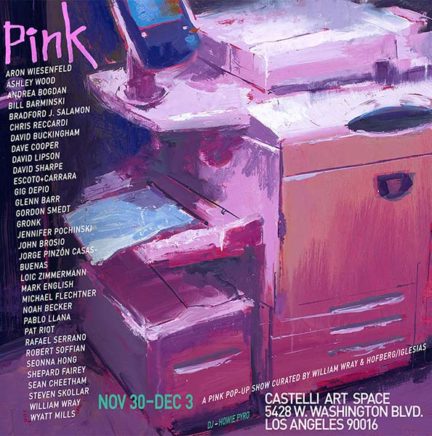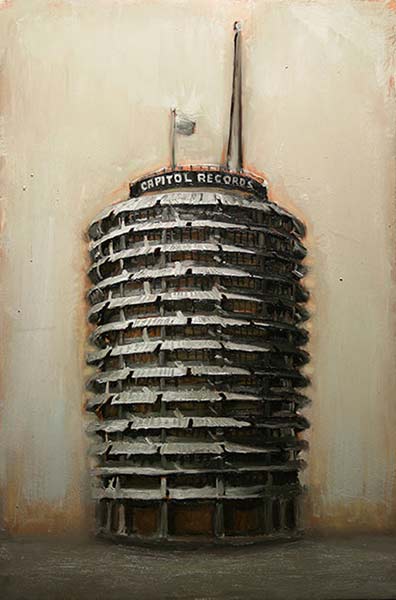The Pink Show at Castelli Art Space • November 30 – December 3, 2017
5428 W. Washington Blvd. • Los Angeles, CA. 90016
For show information contact [email protected]
Salamon is known for his figurative paintings and drawings of individuals and groups who engage in profound human scenarios. Currently, he expands his repertoire to include intimate portraits of vintage objects of yesteryear, as well as films about artists and the nature of creativity. Knowing that content cannot be conveyed in just one work of art, or expressed in only one medium, Salamon has found his personal solution. While portraiture is one of the oldest subjects, Salamon brings a newer dimension to the tried and true art. He renders in-depth views of each sitter, a biographical approach, a dialogue as he captures the many aspects of the sitter through multi-media in various sessions.
The artist, who never lacks for commissions, prefers to choose a sitter, rather than have someone ask him “to do” a portrait. Those he decides to portray in depth are people he highly admires – creative artists, writers, and musicians. In this approach, the artist builds a stockpile of reflections, capturing ever-evolving nuances of character, personality, drama, and story. He gets into the psyche of the sitter, painting a more accurate reality of each person he portrays.
Salamon combines traditional techniques with documentation to celebrate a person’s life. His biographical approach results in a rich bounty of art that deepens the relationship between sitter and artist. Once the many works of art concerning one person are assembled, the soul of the sitter and the soul of the artist can more truthfully emerge.
Among his subjects is a portrait of Eric Johnson, the contemporary sculptor who is a master at capturing scientific concepts in abstract sculptural form. In his work Johnson uses super bright colors with space-age surfaces that are clean and smooth. Salamon, however, paints the sculptor in deep browns and grays as if he portrays (portrays not portrayed) him in Rembrandt’s time. In this way, Salamon shows that an artist of the caliber of Johnson creates timeless art that is connected to all art history, not just to our era of slick modernity.
With pencil, charcoal, paint, or camera, Salamon meets the sitter as if for the first time, finding fresh qualities, which may not have been revealed in previous sessions. Working with several portraits over extended and various lengths of time, Salamon states that painting many intimate renderings of the same person: “Deepens my relationships with other human beings that no other act would accomplish. The process of painting is an interaction which cannot be done from memory. Human beings are three-dimensional. In order to portray the real person, the artist must interact. Spending hours and hours cannot help but deepen the connection and affect the art. This close kinship brings out the intimate details of the sitter and his or her creative nature; and the artist’s response to it.”
The stereotype of the artist and sitter is that the artist paints while the sitter remains immobile. However, Salamon is interested in portraying a flesh and blood human, an energetic individual, a multidimensional a live person rendered through multiple media. Consequently, he allows the viewer to move and talk, ensuring that the art never becomes stale. As he blocks in color, bone structure, light and dark and overall contour, the person dialogues with him, turning, moving, and animating a range of gestures. As Salamon applies washes of color, he builds up planes where corners of planes shift or come together, and body structures alter.
Add to this that Salamon is aware of the three-dimensionality of color, light and temperature, the heat and cool that color emits. Salamon does not stop in the process. He makes alterations, color adjustments, determine how clothing relates to each other, or how the background dialogues with the foreground. Continuously talking, moving a brush rapidly, mixing paint, and checking the person in front of him, he monitors all phases of the emerging painting.
Using his iPhone while working is an added bonus; when there is a stop in the action, he not only takes a picture of his painting, but soon develops a collection of stages in the painting’s progress. For Salamon, reducing the painting to a smaller image, along with different views helps him be aware of the many facets of the process. Looking at an image he may have created minutes before allows him to transcend time, to be in more than one time zone as he builds the image, like an architect aware of all phases and dimensions of a building being erected.
Salamon blocks out specific details and makes determinations to check edges, hard edges, soft edges, or contrasts, such as in the mouth and corners of the mouth. Color of hair, skin, eyes, merge along with the soft edges as bodily planes meet, as he continuously works outward in, going from large to smaller areas and then to subtle details. At times, he works from a static image such as a photograph. To overcome the possibility of becoming dry, he returns to his life drawings for reference. He does not draw while he paints, but looks at the many sketches such as those on his iPhone to review their essence more quickly.
Asked why he now is drawn to vintage objects such as a discarded oil can, an outdated typewriter, or unknown gadgetry, he responds: “I will paint people forever, as they are always important to me. But my fascination with inanimate objects and the stories they tell bring me back to a different time when it makes me move into the mindset of a designer or inventor who thought with 1920 references. Old glass bottles, iconography, out-of-date sewing machines, their shapes and how they work stimulate me to see the world with fresh perceptions.” Salamon’s choice of vintage is the well-designed and well-made detritus that was once revered. For him, these objects have an edge that connects the past with the present and expands the artist’s range of perceiving the world around him. For Salamon this is what the art process is all about.
Knowing his voracious appetite for finding ways to understand people, ideas, and the essence of art, it is natural that Salamon also has successfully taken up filmmaking. He works with significant artists and art critics to produce 15 minute films that give an audience an intimate look at the nature of an artist and the art produced. At the moment, Salamon has created about 10 short films of Los Angeles artists under the theme of “Looking for Genius.” These include Alex Schaefer, Matt Gleason, Don Bachardy and others. Salamon’s dream is for each artist to recommend another artist as he forges links that connect artist to artist in places beyond the known, finding a hidden genius, who creates really great works of art.
Over the years, Salamon has had many exhibitions and his work is sought by fine collectors. His art is largely shown in California and New York.”

PINK announcement by William Wray

